Business Risk Analysis Report for Telstra Corporation Limited
VerifiedAdded on 2020/03/02
|23
|4257
|29
Report
AI Summary
This report offers a comprehensive business risk analysis of Telstra Corporation Limited, examining both internal and external factors influencing its operations within the Australian telecommunications industry. It begins with an executive summary and table of contents, followed by an introduction that highlights the significance of risk analysis in modern business environments. The report then provides an overview of Telstra's nature as an entity, including its products, financial standing, and corporate social responsibility initiatives. It continues with an industry report, outlining the competitive landscape and market share dynamics, followed by an assessment of the legal environment. The core of the analysis involves the application of PEST, Porter's Five Forces, and SWOT analyses to evaluate political, economic, social, and technological factors, competitive forces, and Telstra's strengths, weaknesses, opportunities, and threats. Financial performance is also assessed using key ratios. The report concludes with a discussion on management and governance, offering recommendations based on the findings. References are included to support the analysis.

Running head: BUSINESS RISK ANALYSIS REPORT
Business Risk Analysis Report
Name of the Student
Name of the University
Author’s Note
Business Risk Analysis Report
Name of the Student
Name of the University
Author’s Note
Paraphrase This Document
Need a fresh take? Get an instant paraphrase of this document with our AI Paraphraser
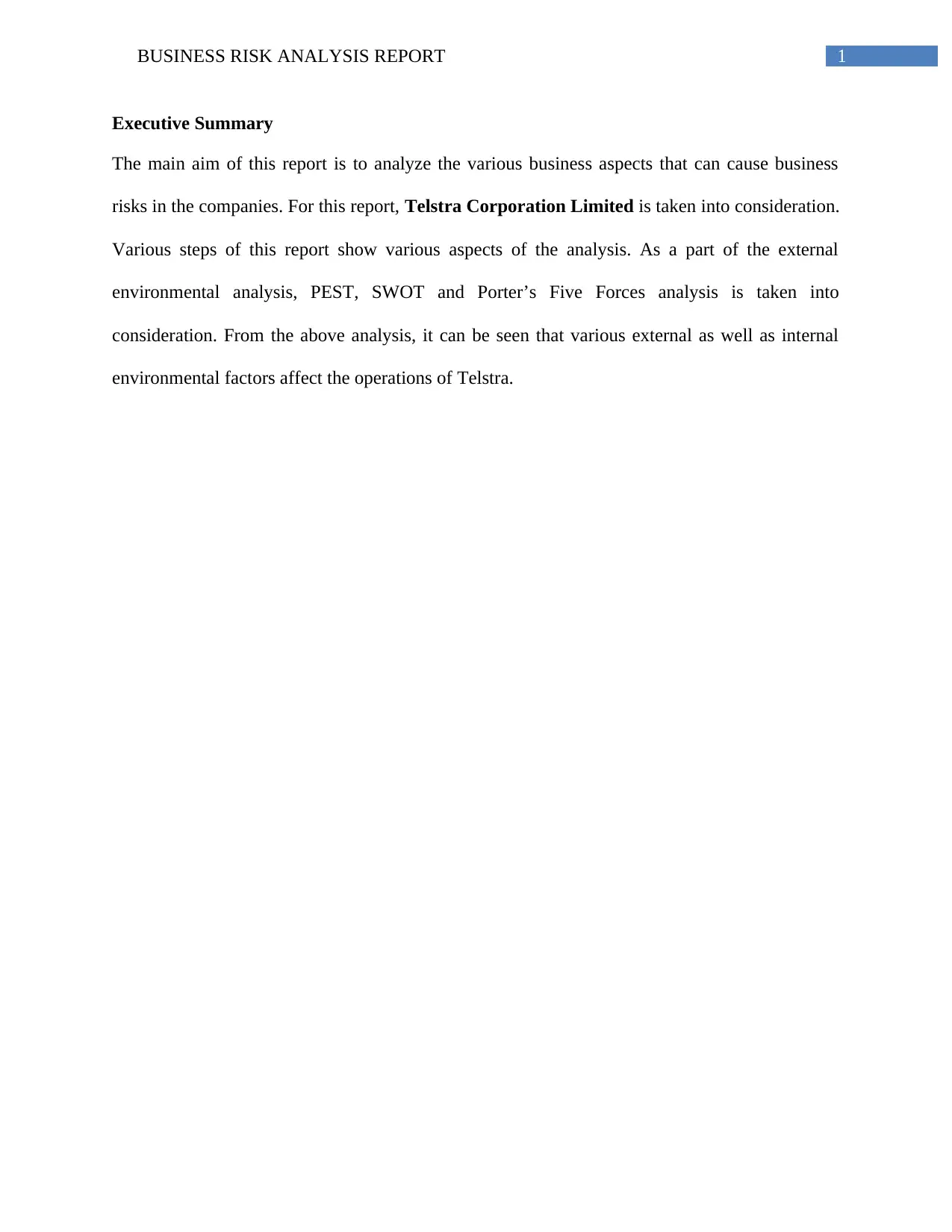
1BUSINESS RISK ANALYSIS REPORT
Executive Summary
The main aim of this report is to analyze the various business aspects that can cause business
risks in the companies. For this report, Telstra Corporation Limited is taken into consideration.
Various steps of this report show various aspects of the analysis. As a part of the external
environmental analysis, PEST, SWOT and Porter’s Five Forces analysis is taken into
consideration. From the above analysis, it can be seen that various external as well as internal
environmental factors affect the operations of Telstra.
Executive Summary
The main aim of this report is to analyze the various business aspects that can cause business
risks in the companies. For this report, Telstra Corporation Limited is taken into consideration.
Various steps of this report show various aspects of the analysis. As a part of the external
environmental analysis, PEST, SWOT and Porter’s Five Forces analysis is taken into
consideration. From the above analysis, it can be seen that various external as well as internal
environmental factors affect the operations of Telstra.
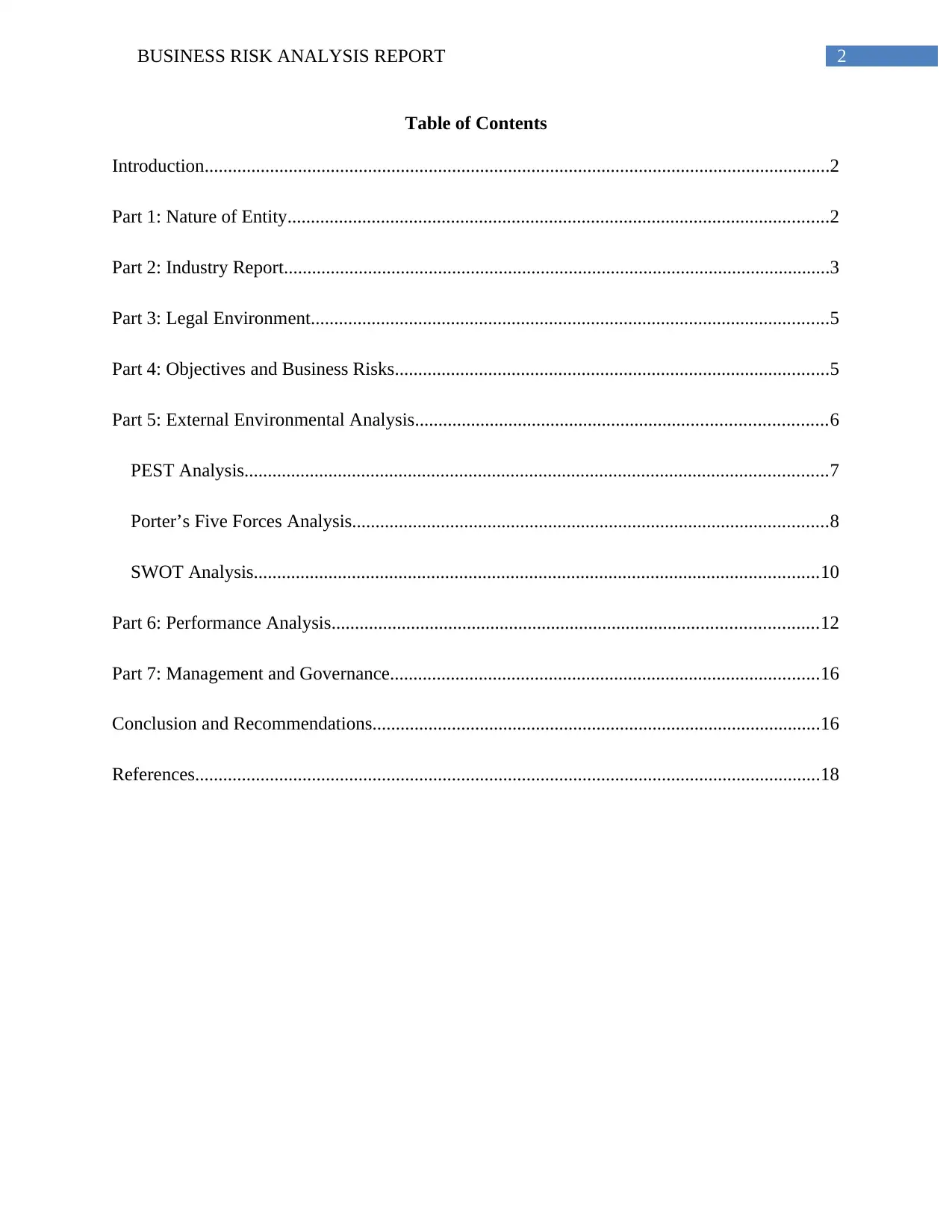
2BUSINESS RISK ANALYSIS REPORT
Table of Contents
Introduction......................................................................................................................................2
Part 1: Nature of Entity....................................................................................................................2
Part 2: Industry Report.....................................................................................................................3
Part 3: Legal Environment...............................................................................................................5
Part 4: Objectives and Business Risks.............................................................................................5
Part 5: External Environmental Analysis........................................................................................6
PEST Analysis.............................................................................................................................7
Porter’s Five Forces Analysis......................................................................................................8
SWOT Analysis.........................................................................................................................10
Part 6: Performance Analysis........................................................................................................12
Part 7: Management and Governance............................................................................................16
Conclusion and Recommendations................................................................................................16
References......................................................................................................................................18
Table of Contents
Introduction......................................................................................................................................2
Part 1: Nature of Entity....................................................................................................................2
Part 2: Industry Report.....................................................................................................................3
Part 3: Legal Environment...............................................................................................................5
Part 4: Objectives and Business Risks.............................................................................................5
Part 5: External Environmental Analysis........................................................................................6
PEST Analysis.............................................................................................................................7
Porter’s Five Forces Analysis......................................................................................................8
SWOT Analysis.........................................................................................................................10
Part 6: Performance Analysis........................................................................................................12
Part 7: Management and Governance............................................................................................16
Conclusion and Recommendations................................................................................................16
References......................................................................................................................................18
⊘ This is a preview!⊘
Do you want full access?
Subscribe today to unlock all pages.

Trusted by 1+ million students worldwide
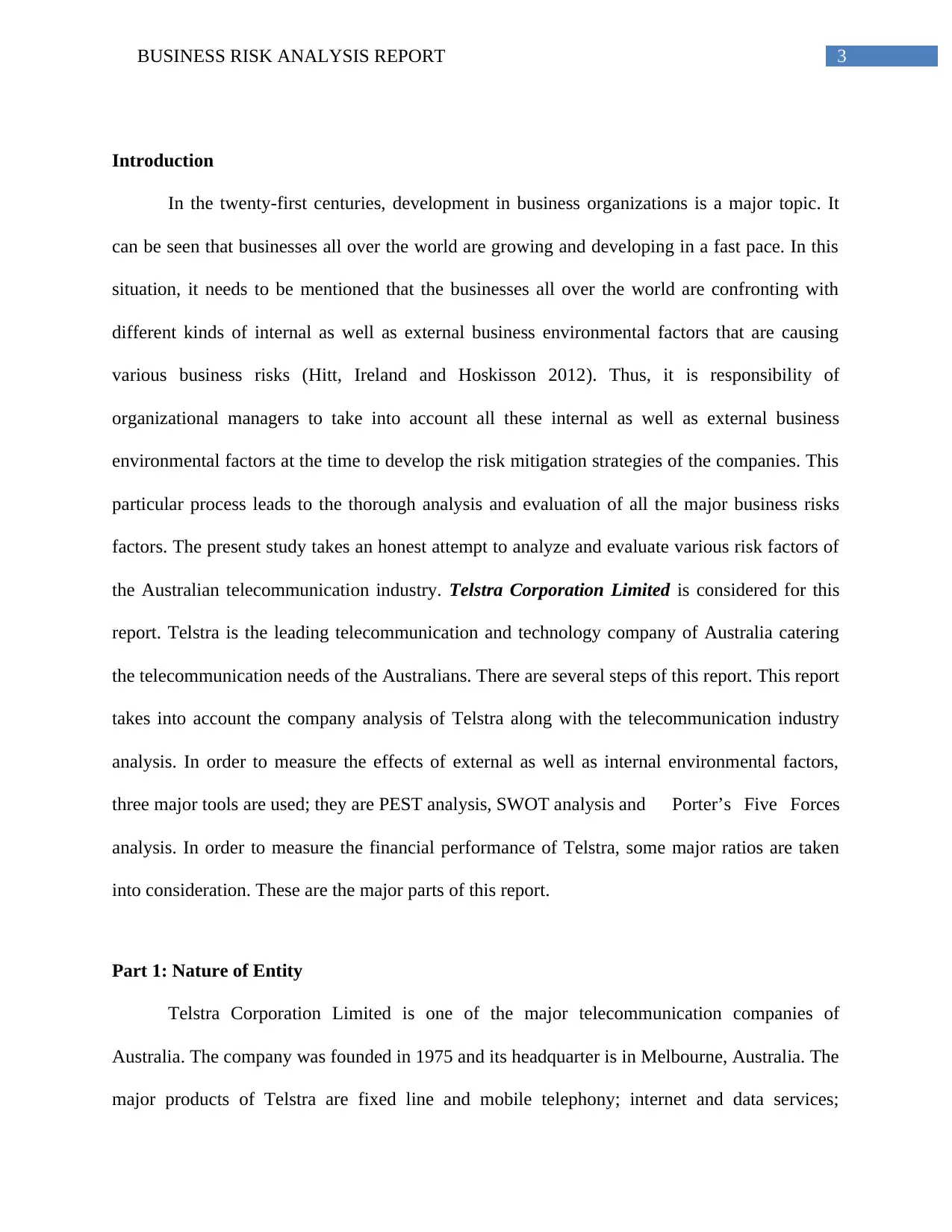
3BUSINESS RISK ANALYSIS REPORT
Introduction
In the twenty-first centuries, development in business organizations is a major topic. It
can be seen that businesses all over the world are growing and developing in a fast pace. In this
situation, it needs to be mentioned that the businesses all over the world are confronting with
different kinds of internal as well as external business environmental factors that are causing
various business risks (Hitt, Ireland and Hoskisson 2012). Thus, it is responsibility of
organizational managers to take into account all these internal as well as external business
environmental factors at the time to develop the risk mitigation strategies of the companies. This
particular process leads to the thorough analysis and evaluation of all the major business risks
factors. The present study takes an honest attempt to analyze and evaluate various risk factors of
the Australian telecommunication industry. Telstra Corporation Limited is considered for this
report. Telstra is the leading telecommunication and technology company of Australia catering
the telecommunication needs of the Australians. There are several steps of this report. This report
takes into account the company analysis of Telstra along with the telecommunication industry
analysis. In order to measure the effects of external as well as internal environmental factors,
three major tools are used; they are PEST analysis, SWOT analysis and Porter’s Five Forces
analysis. In order to measure the financial performance of Telstra, some major ratios are taken
into consideration. These are the major parts of this report.
Part 1: Nature of Entity
Telstra Corporation Limited is one of the major telecommunication companies of
Australia. The company was founded in 1975 and its headquarter is in Melbourne, Australia. The
major products of Telstra are fixed line and mobile telephony; internet and data services;
Introduction
In the twenty-first centuries, development in business organizations is a major topic. It
can be seen that businesses all over the world are growing and developing in a fast pace. In this
situation, it needs to be mentioned that the businesses all over the world are confronting with
different kinds of internal as well as external business environmental factors that are causing
various business risks (Hitt, Ireland and Hoskisson 2012). Thus, it is responsibility of
organizational managers to take into account all these internal as well as external business
environmental factors at the time to develop the risk mitigation strategies of the companies. This
particular process leads to the thorough analysis and evaluation of all the major business risks
factors. The present study takes an honest attempt to analyze and evaluate various risk factors of
the Australian telecommunication industry. Telstra Corporation Limited is considered for this
report. Telstra is the leading telecommunication and technology company of Australia catering
the telecommunication needs of the Australians. There are several steps of this report. This report
takes into account the company analysis of Telstra along with the telecommunication industry
analysis. In order to measure the effects of external as well as internal environmental factors,
three major tools are used; they are PEST analysis, SWOT analysis and Porter’s Five Forces
analysis. In order to measure the financial performance of Telstra, some major ratios are taken
into consideration. These are the major parts of this report.
Part 1: Nature of Entity
Telstra Corporation Limited is one of the major telecommunication companies of
Australia. The company was founded in 1975 and its headquarter is in Melbourne, Australia. The
major products of Telstra are fixed line and mobile telephony; internet and data services;
Paraphrase This Document
Need a fresh take? Get an instant paraphrase of this document with our AI Paraphraser
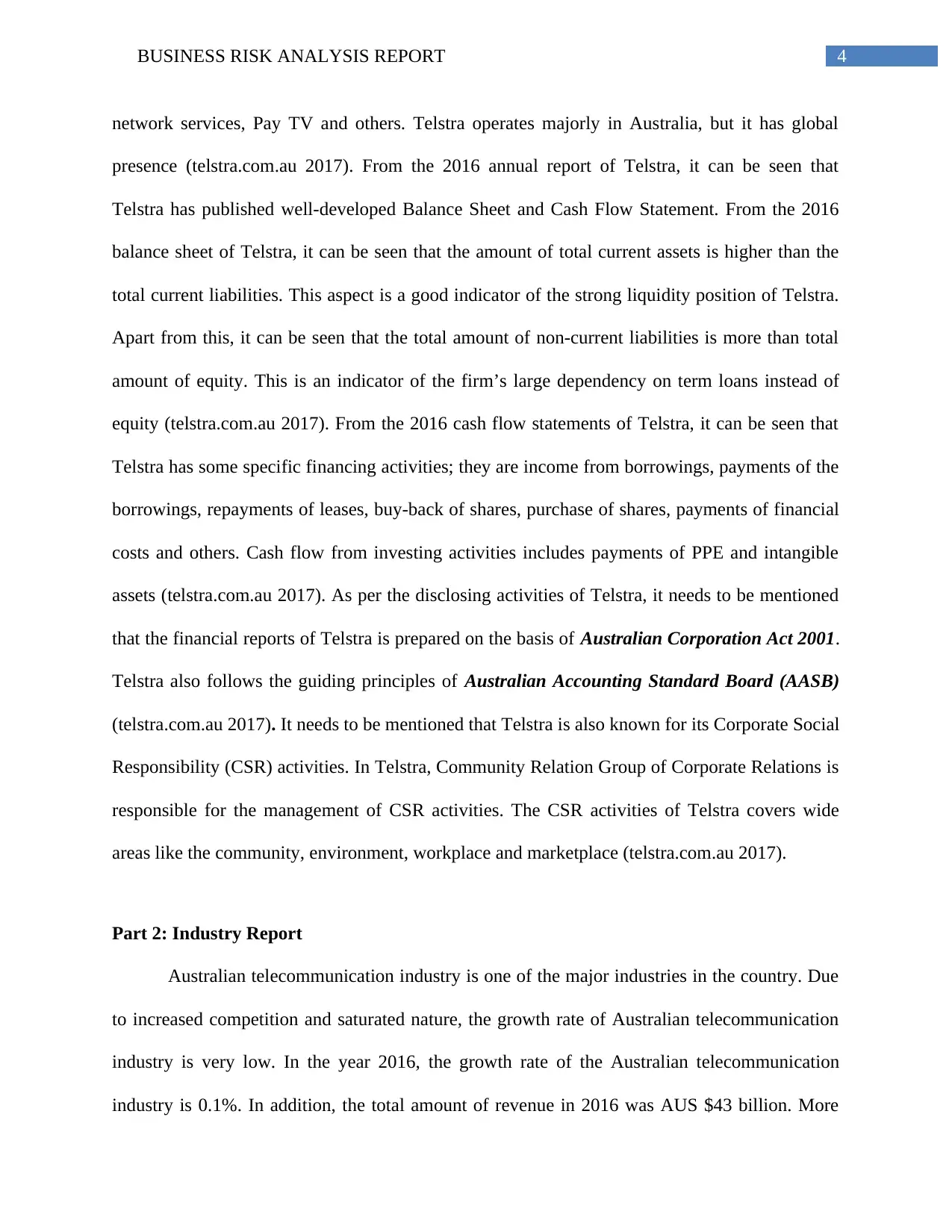
4BUSINESS RISK ANALYSIS REPORT
network services, Pay TV and others. Telstra operates majorly in Australia, but it has global
presence (telstra.com.au 2017). From the 2016 annual report of Telstra, it can be seen that
Telstra has published well-developed Balance Sheet and Cash Flow Statement. From the 2016
balance sheet of Telstra, it can be seen that the amount of total current assets is higher than the
total current liabilities. This aspect is a good indicator of the strong liquidity position of Telstra.
Apart from this, it can be seen that the total amount of non-current liabilities is more than total
amount of equity. This is an indicator of the firm’s large dependency on term loans instead of
equity (telstra.com.au 2017). From the 2016 cash flow statements of Telstra, it can be seen that
Telstra has some specific financing activities; they are income from borrowings, payments of the
borrowings, repayments of leases, buy-back of shares, purchase of shares, payments of financial
costs and others. Cash flow from investing activities includes payments of PPE and intangible
assets (telstra.com.au 2017). As per the disclosing activities of Telstra, it needs to be mentioned
that the financial reports of Telstra is prepared on the basis of Australian Corporation Act 2001.
Telstra also follows the guiding principles of Australian Accounting Standard Board (AASB)
(telstra.com.au 2017). It needs to be mentioned that Telstra is also known for its Corporate Social
Responsibility (CSR) activities. In Telstra, Community Relation Group of Corporate Relations is
responsible for the management of CSR activities. The CSR activities of Telstra covers wide
areas like the community, environment, workplace and marketplace (telstra.com.au 2017).
Part 2: Industry Report
Australian telecommunication industry is one of the major industries in the country. Due
to increased competition and saturated nature, the growth rate of Australian telecommunication
industry is very low. In the year 2016, the growth rate of the Australian telecommunication
industry is 0.1%. In addition, the total amount of revenue in 2016 was AUS $43 billion. More
network services, Pay TV and others. Telstra operates majorly in Australia, but it has global
presence (telstra.com.au 2017). From the 2016 annual report of Telstra, it can be seen that
Telstra has published well-developed Balance Sheet and Cash Flow Statement. From the 2016
balance sheet of Telstra, it can be seen that the amount of total current assets is higher than the
total current liabilities. This aspect is a good indicator of the strong liquidity position of Telstra.
Apart from this, it can be seen that the total amount of non-current liabilities is more than total
amount of equity. This is an indicator of the firm’s large dependency on term loans instead of
equity (telstra.com.au 2017). From the 2016 cash flow statements of Telstra, it can be seen that
Telstra has some specific financing activities; they are income from borrowings, payments of the
borrowings, repayments of leases, buy-back of shares, purchase of shares, payments of financial
costs and others. Cash flow from investing activities includes payments of PPE and intangible
assets (telstra.com.au 2017). As per the disclosing activities of Telstra, it needs to be mentioned
that the financial reports of Telstra is prepared on the basis of Australian Corporation Act 2001.
Telstra also follows the guiding principles of Australian Accounting Standard Board (AASB)
(telstra.com.au 2017). It needs to be mentioned that Telstra is also known for its Corporate Social
Responsibility (CSR) activities. In Telstra, Community Relation Group of Corporate Relations is
responsible for the management of CSR activities. The CSR activities of Telstra covers wide
areas like the community, environment, workplace and marketplace (telstra.com.au 2017).
Part 2: Industry Report
Australian telecommunication industry is one of the major industries in the country. Due
to increased competition and saturated nature, the growth rate of Australian telecommunication
industry is very low. In the year 2016, the growth rate of the Australian telecommunication
industry is 0.1%. In addition, the total amount of revenue in 2016 was AUS $43 billion. More
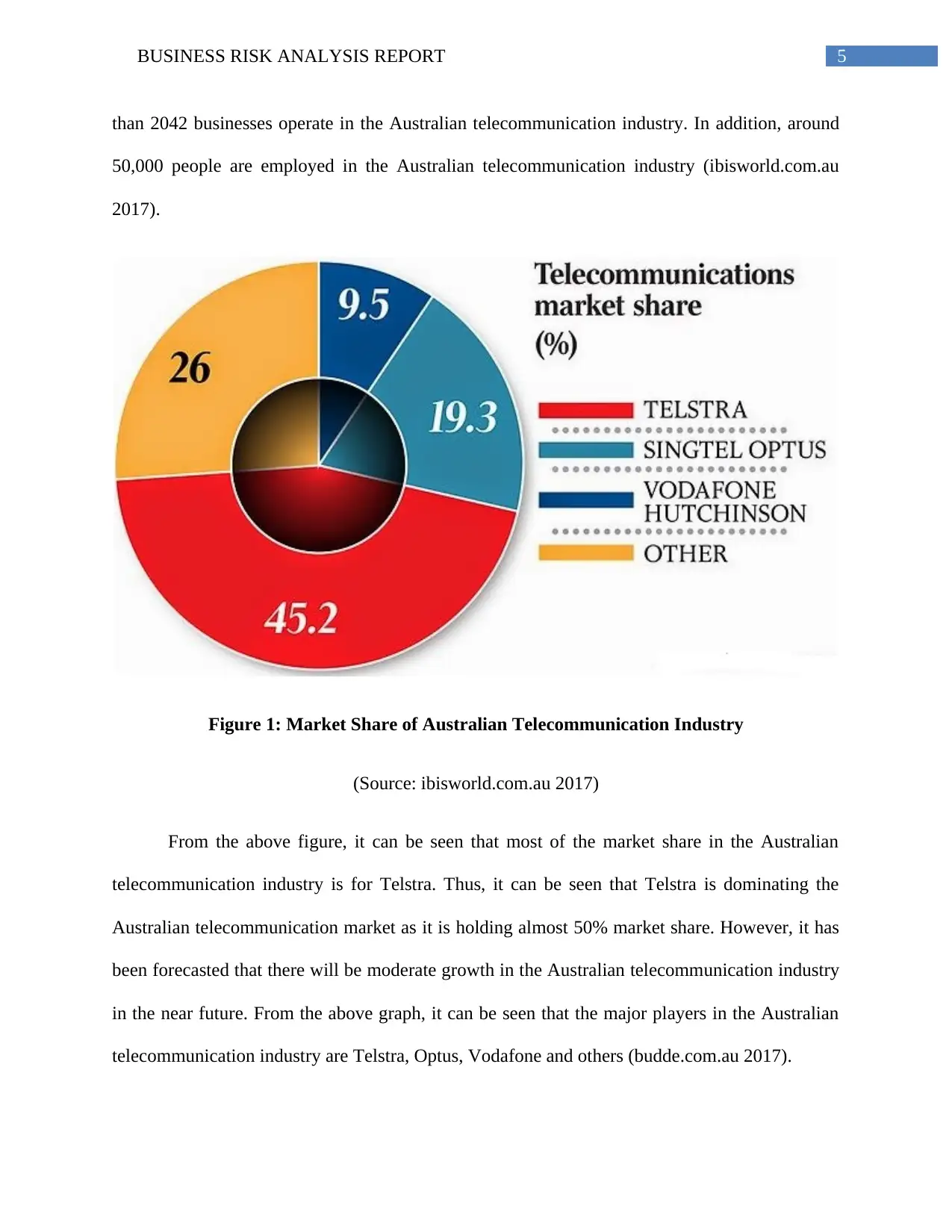
5BUSINESS RISK ANALYSIS REPORT
than 2042 businesses operate in the Australian telecommunication industry. In addition, around
50,000 people are employed in the Australian telecommunication industry (ibisworld.com.au
2017).
Figure 1: Market Share of Australian Telecommunication Industry
(Source: ibisworld.com.au 2017)
From the above figure, it can be seen that most of the market share in the Australian
telecommunication industry is for Telstra. Thus, it can be seen that Telstra is dominating the
Australian telecommunication market as it is holding almost 50% market share. However, it has
been forecasted that there will be moderate growth in the Australian telecommunication industry
in the near future. From the above graph, it can be seen that the major players in the Australian
telecommunication industry are Telstra, Optus, Vodafone and others (budde.com.au 2017).
than 2042 businesses operate in the Australian telecommunication industry. In addition, around
50,000 people are employed in the Australian telecommunication industry (ibisworld.com.au
2017).
Figure 1: Market Share of Australian Telecommunication Industry
(Source: ibisworld.com.au 2017)
From the above figure, it can be seen that most of the market share in the Australian
telecommunication industry is for Telstra. Thus, it can be seen that Telstra is dominating the
Australian telecommunication market as it is holding almost 50% market share. However, it has
been forecasted that there will be moderate growth in the Australian telecommunication industry
in the near future. From the above graph, it can be seen that the major players in the Australian
telecommunication industry are Telstra, Optus, Vodafone and others (budde.com.au 2017).
⊘ This is a preview!⊘
Do you want full access?
Subscribe today to unlock all pages.

Trusted by 1+ million students worldwide
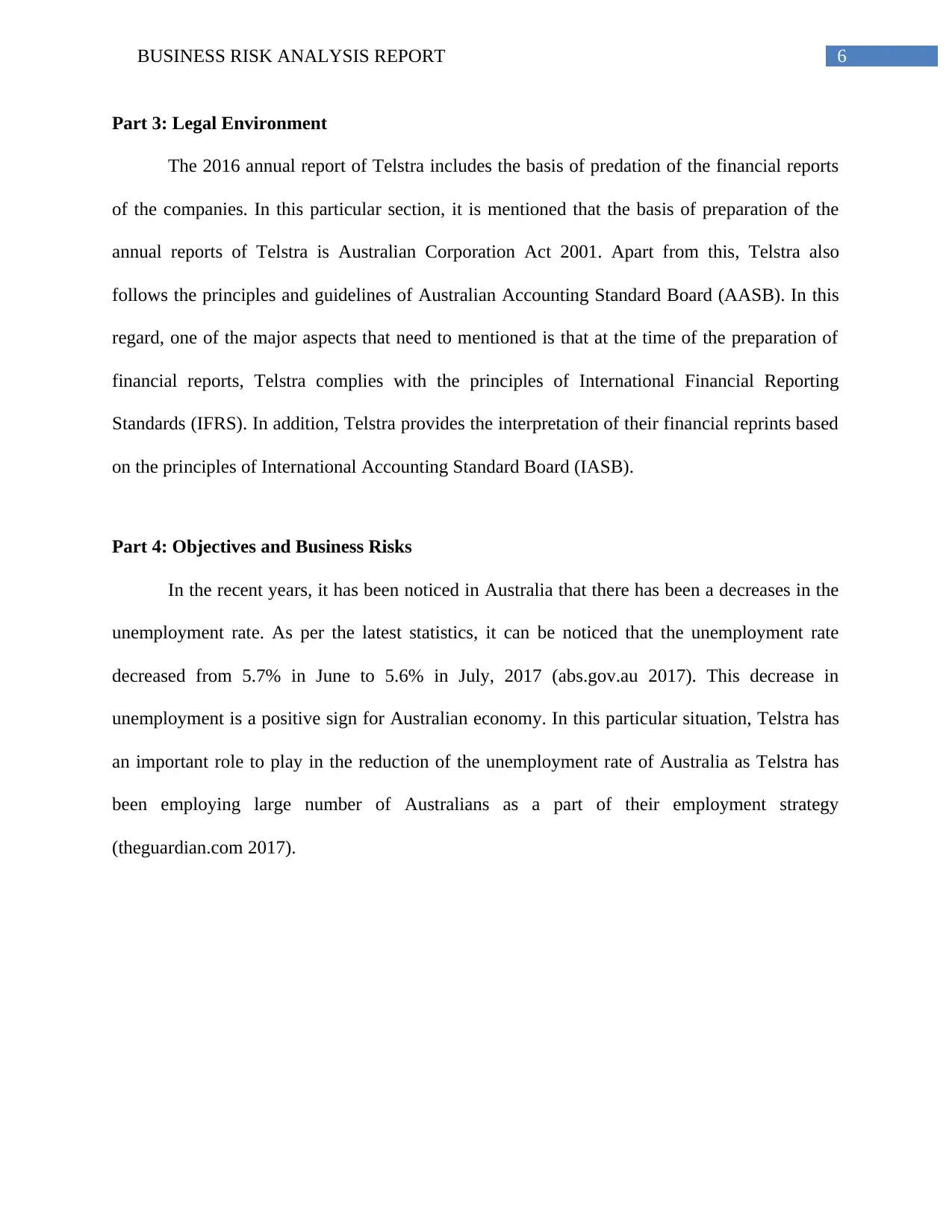
6BUSINESS RISK ANALYSIS REPORT
Part 3: Legal Environment
The 2016 annual report of Telstra includes the basis of predation of the financial reports
of the companies. In this particular section, it is mentioned that the basis of preparation of the
annual reports of Telstra is Australian Corporation Act 2001. Apart from this, Telstra also
follows the principles and guidelines of Australian Accounting Standard Board (AASB). In this
regard, one of the major aspects that need to mentioned is that at the time of the preparation of
financial reports, Telstra complies with the principles of International Financial Reporting
Standards (IFRS). In addition, Telstra provides the interpretation of their financial reprints based
on the principles of International Accounting Standard Board (IASB).
Part 4: Objectives and Business Risks
In the recent years, it has been noticed in Australia that there has been a decreases in the
unemployment rate. As per the latest statistics, it can be noticed that the unemployment rate
decreased from 5.7% in June to 5.6% in July, 2017 (abs.gov.au 2017). This decrease in
unemployment is a positive sign for Australian economy. In this particular situation, Telstra has
an important role to play in the reduction of the unemployment rate of Australia as Telstra has
been employing large number of Australians as a part of their employment strategy
(theguardian.com 2017).
Part 3: Legal Environment
The 2016 annual report of Telstra includes the basis of predation of the financial reports
of the companies. In this particular section, it is mentioned that the basis of preparation of the
annual reports of Telstra is Australian Corporation Act 2001. Apart from this, Telstra also
follows the principles and guidelines of Australian Accounting Standard Board (AASB). In this
regard, one of the major aspects that need to mentioned is that at the time of the preparation of
financial reports, Telstra complies with the principles of International Financial Reporting
Standards (IFRS). In addition, Telstra provides the interpretation of their financial reprints based
on the principles of International Accounting Standard Board (IASB).
Part 4: Objectives and Business Risks
In the recent years, it has been noticed in Australia that there has been a decreases in the
unemployment rate. As per the latest statistics, it can be noticed that the unemployment rate
decreased from 5.7% in June to 5.6% in July, 2017 (abs.gov.au 2017). This decrease in
unemployment is a positive sign for Australian economy. In this particular situation, Telstra has
an important role to play in the reduction of the unemployment rate of Australia as Telstra has
been employing large number of Australians as a part of their employment strategy
(theguardian.com 2017).
Paraphrase This Document
Need a fresh take? Get an instant paraphrase of this document with our AI Paraphraser
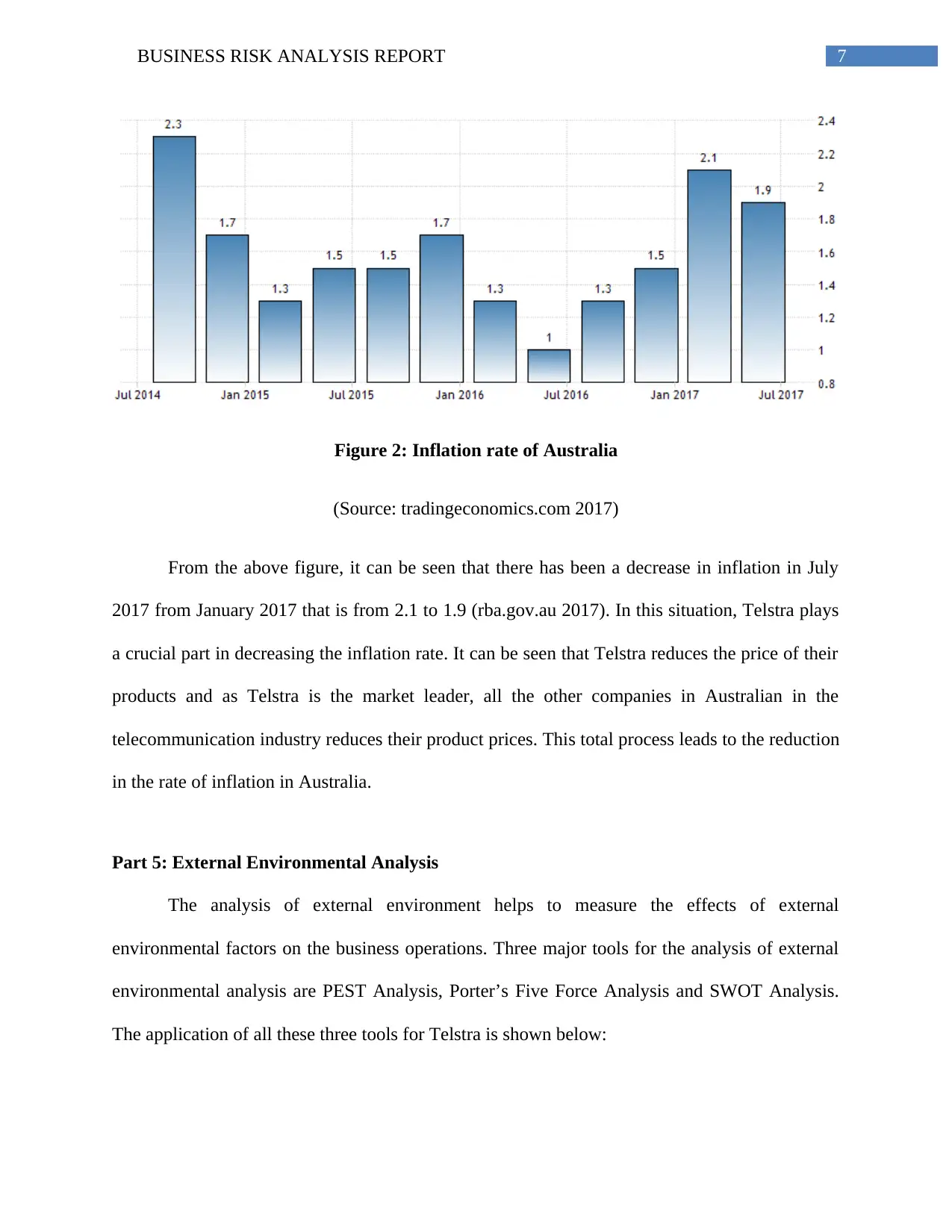
7BUSINESS RISK ANALYSIS REPORT
Figure 2: Inflation rate of Australia
(Source: tradingeconomics.com 2017)
From the above figure, it can be seen that there has been a decrease in inflation in July
2017 from January 2017 that is from 2.1 to 1.9 (rba.gov.au 2017). In this situation, Telstra plays
a crucial part in decreasing the inflation rate. It can be seen that Telstra reduces the price of their
products and as Telstra is the market leader, all the other companies in Australian in the
telecommunication industry reduces their product prices. This total process leads to the reduction
in the rate of inflation in Australia.
Part 5: External Environmental Analysis
The analysis of external environment helps to measure the effects of external
environmental factors on the business operations. Three major tools for the analysis of external
environmental analysis are PEST Analysis, Porter’s Five Force Analysis and SWOT Analysis.
The application of all these three tools for Telstra is shown below:
Figure 2: Inflation rate of Australia
(Source: tradingeconomics.com 2017)
From the above figure, it can be seen that there has been a decrease in inflation in July
2017 from January 2017 that is from 2.1 to 1.9 (rba.gov.au 2017). In this situation, Telstra plays
a crucial part in decreasing the inflation rate. It can be seen that Telstra reduces the price of their
products and as Telstra is the market leader, all the other companies in Australian in the
telecommunication industry reduces their product prices. This total process leads to the reduction
in the rate of inflation in Australia.
Part 5: External Environmental Analysis
The analysis of external environment helps to measure the effects of external
environmental factors on the business operations. Three major tools for the analysis of external
environmental analysis are PEST Analysis, Porter’s Five Force Analysis and SWOT Analysis.
The application of all these three tools for Telstra is shown below:

8BUSINESS RISK ANALYSIS REPORT
PEST Analysis
The factors in PEST analysis is shown below:
Figure 3: Factors in PEST Analysis
(Source: Ho 2014)
Political Factors: Government regulation is a major issue in the telecommunication industry of
Australia as change in the telecommunication regulations can be seen frequently. Thus, Telstra
has to comply with all these issues frequently. Sometime these government regulations affect the
business operation of Telstra. However, in overall basis, the political condition of Australia
stable that supports the business activities of Telstra (Marsh and Miller 2012).
Economical Factors: Some of the major economical factors that affect the business operation of
Telstar are rate of interest, inflation rate and huge amount of taxes. In addition, the worldwide
economic crisis is also affecting the business operations of Telstra. For Telstra, it is expensive
PESTAnalysisPOLITICALECONOMICSOCIALTECHNOLOGICAL
PEST Analysis
The factors in PEST analysis is shown below:
Figure 3: Factors in PEST Analysis
(Source: Ho 2014)
Political Factors: Government regulation is a major issue in the telecommunication industry of
Australia as change in the telecommunication regulations can be seen frequently. Thus, Telstra
has to comply with all these issues frequently. Sometime these government regulations affect the
business operation of Telstra. However, in overall basis, the political condition of Australia
stable that supports the business activities of Telstra (Marsh and Miller 2012).
Economical Factors: Some of the major economical factors that affect the business operation of
Telstar are rate of interest, inflation rate and huge amount of taxes. In addition, the worldwide
economic crisis is also affecting the business operations of Telstra. For Telstra, it is expensive
PESTAnalysisPOLITICALECONOMICSOCIALTECHNOLOGICAL
⊘ This is a preview!⊘
Do you want full access?
Subscribe today to unlock all pages.

Trusted by 1+ million students worldwide

9BUSINESS RISK ANALYSIS REPORT
for them to set towers and resources in the rural areas. There is an increase need for the required
resources for Telstra as they are a growing company. However, increase in the disposal income
of Australians is helping Telstra to maximize their revenues (McLean 2012).
Social Factors: There is a limited growth opportunity for Telstra as it is difficult for the
telecommunication companies to expand in rural areas. Customers are left with very few options
while taking the services of mobile, internet and television packages. However, it can be seen
that different types of telecommunication products are becoming the part of the daily live of
people. This particular aspect leads to the high demand of telecommunication products in
Australia (Board 2012).
Technological Factors: The Australian telecommunication industry largely depends on the
advancements of technologies. It can be seen that the telecommunication industries are using
fiver wires over copper wares in order to provide better services. With the assistance of advanced
technologies, Telstra has become able to provide their customers with more convenient services
and products like voicemail, caller ID and others (Jasa et al. 2012).
Porter’s Five Forces Analysis
The factors in Porter’s Five Forces are shown below:
for them to set towers and resources in the rural areas. There is an increase need for the required
resources for Telstra as they are a growing company. However, increase in the disposal income
of Australians is helping Telstra to maximize their revenues (McLean 2012).
Social Factors: There is a limited growth opportunity for Telstra as it is difficult for the
telecommunication companies to expand in rural areas. Customers are left with very few options
while taking the services of mobile, internet and television packages. However, it can be seen
that different types of telecommunication products are becoming the part of the daily live of
people. This particular aspect leads to the high demand of telecommunication products in
Australia (Board 2012).
Technological Factors: The Australian telecommunication industry largely depends on the
advancements of technologies. It can be seen that the telecommunication industries are using
fiver wires over copper wares in order to provide better services. With the assistance of advanced
technologies, Telstra has become able to provide their customers with more convenient services
and products like voicemail, caller ID and others (Jasa et al. 2012).
Porter’s Five Forces Analysis
The factors in Porter’s Five Forces are shown below:
Paraphrase This Document
Need a fresh take? Get an instant paraphrase of this document with our AI Paraphraser
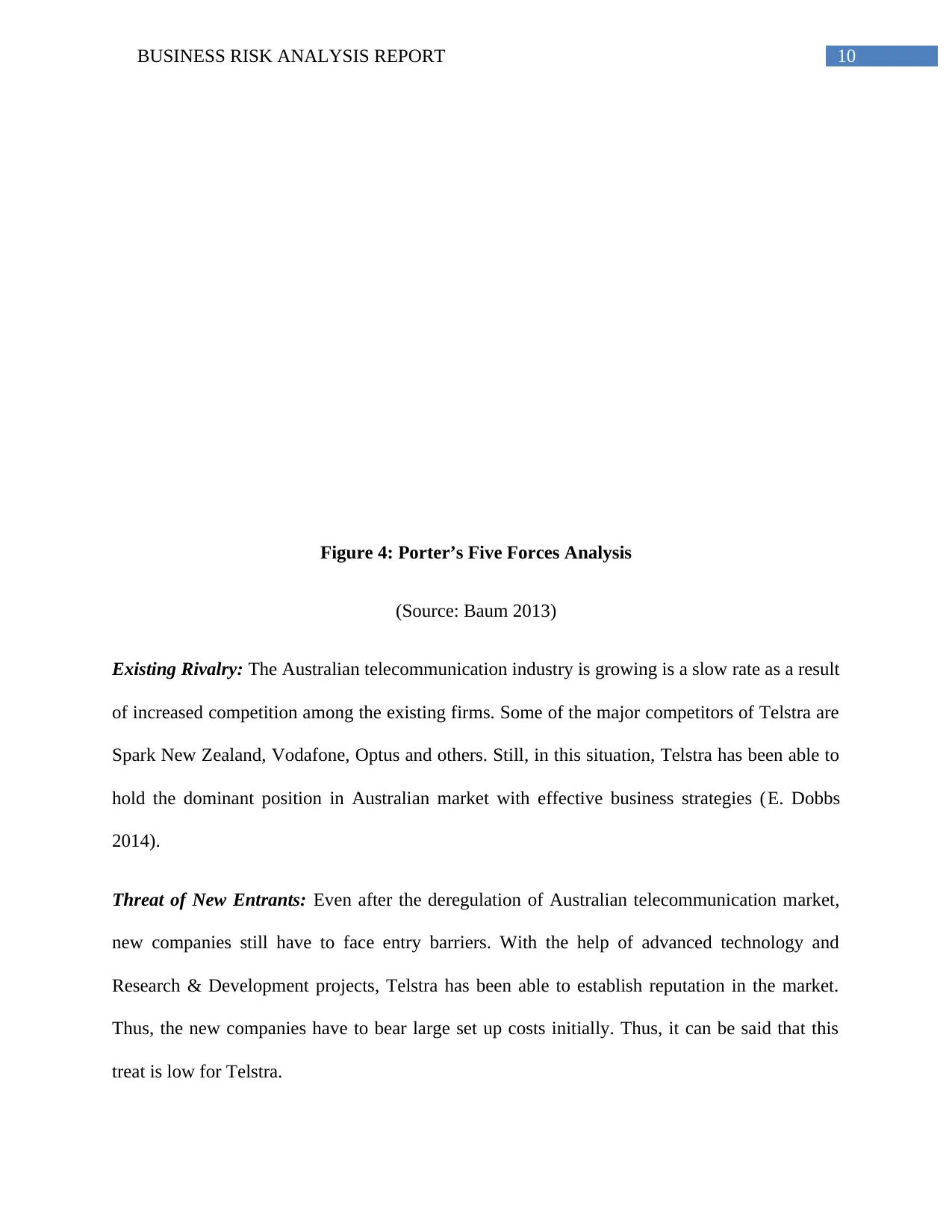
10BUSINESS RISK ANALYSIS REPORT
Figure 4: Porter’s Five Forces Analysis
(Source: Baum 2013)
Existing Rivalry: The Australian telecommunication industry is growing is a slow rate as a result
of increased competition among the existing firms. Some of the major competitors of Telstra are
Spark New Zealand, Vodafone, Optus and others. Still, in this situation, Telstra has been able to
hold the dominant position in Australian market with effective business strategies (E. Dobbs
2014).
Threat of New Entrants: Even after the deregulation of Australian telecommunication market,
new companies still have to face entry barriers. With the help of advanced technology and
Research & Development projects, Telstra has been able to establish reputation in the market.
Thus, the new companies have to bear large set up costs initially. Thus, it can be said that this
treat is low for Telstra.
ExistingRivalryThreatofNewEntrantsBargainingPowerofBuyersBargainigPowerofSuppliersThreatofSubstitute
Figure 4: Porter’s Five Forces Analysis
(Source: Baum 2013)
Existing Rivalry: The Australian telecommunication industry is growing is a slow rate as a result
of increased competition among the existing firms. Some of the major competitors of Telstra are
Spark New Zealand, Vodafone, Optus and others. Still, in this situation, Telstra has been able to
hold the dominant position in Australian market with effective business strategies (E. Dobbs
2014).
Threat of New Entrants: Even after the deregulation of Australian telecommunication market,
new companies still have to face entry barriers. With the help of advanced technology and
Research & Development projects, Telstra has been able to establish reputation in the market.
Thus, the new companies have to bear large set up costs initially. Thus, it can be said that this
treat is low for Telstra.
ExistingRivalryThreatofNewEntrantsBargainingPowerofBuyersBargainigPowerofSuppliersThreatofSubstitute
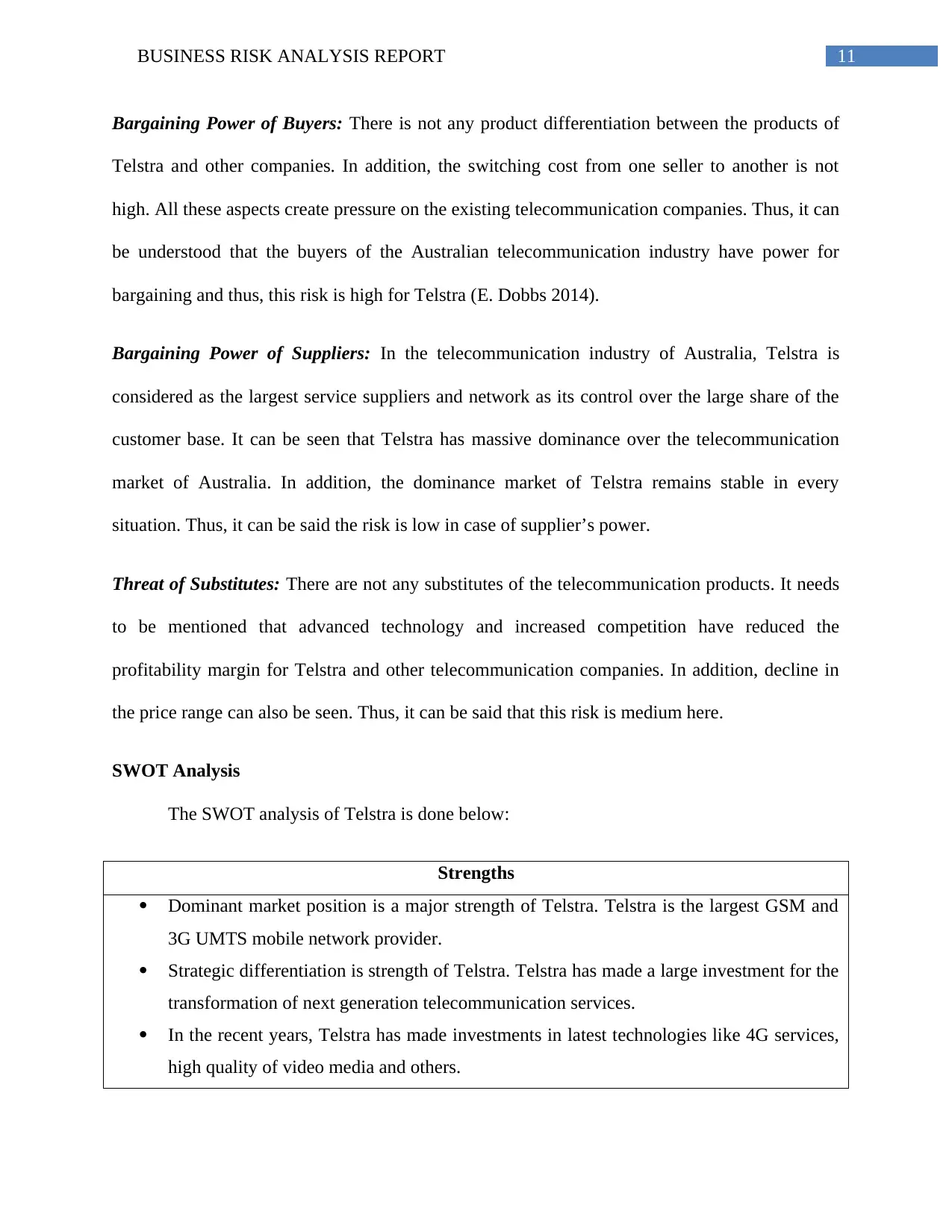
11BUSINESS RISK ANALYSIS REPORT
Bargaining Power of Buyers: There is not any product differentiation between the products of
Telstra and other companies. In addition, the switching cost from one seller to another is not
high. All these aspects create pressure on the existing telecommunication companies. Thus, it can
be understood that the buyers of the Australian telecommunication industry have power for
bargaining and thus, this risk is high for Telstra (E. Dobbs 2014).
Bargaining Power of Suppliers: In the telecommunication industry of Australia, Telstra is
considered as the largest service suppliers and network as its control over the large share of the
customer base. It can be seen that Telstra has massive dominance over the telecommunication
market of Australia. In addition, the dominance market of Telstra remains stable in every
situation. Thus, it can be said the risk is low in case of supplier’s power.
Threat of Substitutes: There are not any substitutes of the telecommunication products. It needs
to be mentioned that advanced technology and increased competition have reduced the
profitability margin for Telstra and other telecommunication companies. In addition, decline in
the price range can also be seen. Thus, it can be said that this risk is medium here.
SWOT Analysis
The SWOT analysis of Telstra is done below:
Strengths
Dominant market position is a major strength of Telstra. Telstra is the largest GSM and
3G UMTS mobile network provider.
Strategic differentiation is strength of Telstra. Telstra has made a large investment for the
transformation of next generation telecommunication services.
In the recent years, Telstra has made investments in latest technologies like 4G services,
high quality of video media and others.
Bargaining Power of Buyers: There is not any product differentiation between the products of
Telstra and other companies. In addition, the switching cost from one seller to another is not
high. All these aspects create pressure on the existing telecommunication companies. Thus, it can
be understood that the buyers of the Australian telecommunication industry have power for
bargaining and thus, this risk is high for Telstra (E. Dobbs 2014).
Bargaining Power of Suppliers: In the telecommunication industry of Australia, Telstra is
considered as the largest service suppliers and network as its control over the large share of the
customer base. It can be seen that Telstra has massive dominance over the telecommunication
market of Australia. In addition, the dominance market of Telstra remains stable in every
situation. Thus, it can be said the risk is low in case of supplier’s power.
Threat of Substitutes: There are not any substitutes of the telecommunication products. It needs
to be mentioned that advanced technology and increased competition have reduced the
profitability margin for Telstra and other telecommunication companies. In addition, decline in
the price range can also be seen. Thus, it can be said that this risk is medium here.
SWOT Analysis
The SWOT analysis of Telstra is done below:
Strengths
Dominant market position is a major strength of Telstra. Telstra is the largest GSM and
3G UMTS mobile network provider.
Strategic differentiation is strength of Telstra. Telstra has made a large investment for the
transformation of next generation telecommunication services.
In the recent years, Telstra has made investments in latest technologies like 4G services,
high quality of video media and others.
⊘ This is a preview!⊘
Do you want full access?
Subscribe today to unlock all pages.

Trusted by 1+ million students worldwide
1 out of 23
Related Documents
Your All-in-One AI-Powered Toolkit for Academic Success.
+13062052269
info@desklib.com
Available 24*7 on WhatsApp / Email
![[object Object]](/_next/static/media/star-bottom.7253800d.svg)
Unlock your academic potential
Copyright © 2020–2025 A2Z Services. All Rights Reserved. Developed and managed by ZUCOL.




